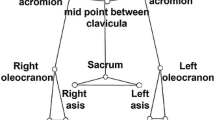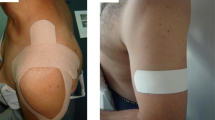Abstract
Purpose
This study aimed to investigate the time-course changes in the active stiffness of the supraspinatus muscle after arthroscopic rotator cuff repair.
Methods
Eight male patients (mean age 61.5 ± 9.4 years) who underwent arthroscopic rotator cuff repair for small to medium tears were recruited for this study. Movement tasks included 30° shoulder isometric abduction and maximal voluntary isometric contraction of shoulder abduction in the scapular plane. The stiffness of the supraspinatus (anterior superficial, anterior deep, posterior superficial, and posterior deep regions), upper trapezius, and middle deltoid muscles in bilateral shoulders was recorded using ultrasound shear wave elastography. For each subject, the measurement was performed preoperatively and 3, 6, and 12 months postoperatively.
Results
The stiffness of the affected anterior superficial region of the supraspinatus muscle 12 months postoperatively was significantly higher than that measured preoperatively and 3 months postoperatively (p < 0.05); it was significantly higher at 6 months postoperatively than at 3 months postoperatively (p < 0.05). Further, the maximal voluntary isometric contraction had significantly improved 12 months postoperatively compared to that measured preoperatively and 3 months postoperatively (p < 0.05). The stiffness of the affected upper trapezius and middle deltoid muscles 12 months postoperatively was significantly lower than that preoperatively (p < 0.05).
Conclusion
The maximal voluntary isometric contraction 12 months postoperatively possibly increased because of improvement in the active stiffness of the anterior superficial region. Active stiffness of the anterior superficial region may improve 6 months rather than 3 months postoperatively because of the different stages of muscle force, structural repair tendon strength, and remodeling.







Similar content being viewed by others
References
Yamamoto A, Takagishi K, Osawa T, et al. Prevalence and risk factors of a rotator cuff tear in the general population. J Shoulder Elbow Surg. 2010;19:116–20.
Nobuhara K. The shoulder: its function and clinical aspects. Tokyo: IGAKU-SHOIN; 2012. p. 176–179.
Ackland DC, Pak P, Richardson M, et al. Moment arms of the muscles crossing the anatomical shoulder. J Anat. 2008;213:383–90.
Alpert SW, Pink MM, Jobe FW, et al. Electromyographic analysis of deltoid and rotator cuff function under varying loads and speeds. J Shoulder Elbow Surg. 2000;9:47–58.
Graichen H, Stammberger T, Bonel H, et al. Glenohumeral translation during active and passive elevation of the shoulder—a 3D open-MRI study. J Biomech. 2000;33:609–13.
Hughes RE, An KN. Force analysis of rotator cuff muscles. Clin Orthop Relat Res. 1996;330:75–83.
Liu J, Hughes RE, Smutz WP, et al. Roles of deltoid and rotator cuff muscles in shoulder elevation. Clin Biomech (Bristol, Avon). 1997;12:32–8.
Otis JC, Jiang CC, Wickiewicz TL, et al. Changes in the moment arms of the rotator cuff and deltoid muscles with abduction and rotation. J Bone Jt Surg Am. 1994;76:667–76.
Kim SY, Bleakney R, Boynton E, et al. Investigation of the static and dynamic musculotendinous architecture of supraspinatus. Clin Anat. 2010;23:48–55.
Kim SY, Boynton EL, Ravichandiran K, et al. Three-dimensional study of the musculotendinous architecture of supraspinatus and its functional correlations. Clin Anat. 2007;20:648–55.
Hata Y, Saitoh S, Murakami N, et al. Volume changes of supraspinatus and infraspinatus muscles after supraspinatus tendon repair: a magnetic resonance imaging study. J Shoulder Elbow Surg. 2005;14:631–5.
Kim SY, Bleakney RR, Rindlisbacher T, et al. Musculotendinous architecture of pathological supraspinatus: a pilot in vivo ultrasonography study. Clin Anat. 2013;26:228–35.
Meyer DC, Pirkl C, Pfirrmann CWA, et al. Asymmetric atrophy of the supraspinatus muscle following tendon tear. J Orthop Res. 2005;23:254–8.
Thomazeau H, Rolland Y, Lucas C, et al. Atrophy of the supraspinatus belly. Assessment by MRI in 55 patients with rotator cuff pathology. Acta Orthop Scand. 1996;67:264–8.
Sakaki Y, Taniguchi K, Kodesho T, et al. Effects of loads of shoulder isometric abduction in the scapular plane on the stiffness of the supraspinatus muscle in patients with rotator cuff tear. J JaSOU. 2018;30:44–50.
Kelly BT, Williams RJ, Cordasco FA, et al. Differential patterns of muscle activation in patients with symptomatic and asymptomatic rotator cuff tears. J Shoulder Elbow Surg. 2005;14:165–71.
Shinozaki N, Sano H, Omi R, et al. Differences in muscle activities during shoulder elevation in patients with symptomatic and asymptomatic rotator cuff tears: analysis by positron emission tomography. J Shoulder Elbow Surg. 2014;23:e61–7.
Terrier A, Reist A, Vogel A, et al. Effect of supraspinatus deficiency on humerus translation and glenohumeral contact force during abduction. Clin Biomech (Bristol, Avon). 2007;22:645–51.
Bouillard K, Nordez A, Hug F. Estimation of individual muscle force using elastography. PLoS ONE. 2011;6:e29261.
Goutallier D, Postel JM, Bernageau J, et al. Fatty muscle degeneration in cuff ruptures. Pre- and postoperative evaluation by CT scan. Clin Orthop Relat Res. 1994;304:78–83.
Cofield RH, Parvizi J, Hoffmeyer PJ, et al. Surgical repair of chronic rotator cuff tears. A prospective long-term study. J Bone Jt Surg Am. 2001;83-A:71–7.
Hatta T, Giambini H, Uehara K, et al. Quantitative assessment of rotator cuff muscle elasticity: reliability and feasibility of shear wave elastography. J Biomech. 2015;48:3853–8.
Itoigawa Y, Sperling JW, Steinmann SP, et al. Feasibility assessment of shear wave elastography to rotator cuff muscle. Clin Anat. 2015;28:213–8.
Ishikawa H, Muraki T, Sekiguchi Y, et al. Noninvasive assessment of the activity of the shoulder girdle muscles using ultrasound real-time tissue elastography. J Electromyogr Kinesiol. 2015;25:723–30.
Taniguchi K, Shinohara M, Nozaki S, et al. Acute decrease in the stiffness of resting muscle belly due to static stretching. Scand J Med Sci Sports. 2015;25:32–40.
Portney LG, Watkins MP. Foundations of clinical research: applications to practice. 4th ed. Philadelphia: F.A. Davis Co; 2019. p. 486–91.
Baumer TG, Dischler J, Davis L, et al. The effects of age and pathology on shear wave speed of the human rotator cuff. J Orthop Res. 2017;36:282–8.
Park YB, Ryu HY, Hong JH, et al. Reversibility of supraspinatus muscle atrophy in tendon-bone healing after arthroscopic rotator cuff repair. Am J Sports Med. 2016;44:981–8.
Bey MJ, Peltz CD, Ciarelli K, et al. In vivo shoulder function after surgical repair of a torn rotator cuff: glenohumeral joint mechanics, shoulder strength, clinical outcomes, and their interaction. Am J Sports Med. 2011;39:2117–29.
Gerber C, Schneeberger AG, Perren SM, et al. Experimental rotator cuff repair. A preliminary study. J Bone Jt Surg Am. 1999;81:1281–90.
Galatz LM, Sandell LJ, Rothermich SY, et al. Characteristics of the rat supraspinatus tendon during tendon-to-bone healing after acute injury. J Orthop Res. 2006;24:541–50.
Acknowledgements
We would like to thank the staff of Hitsujigaoka Hospital and the Sports Physical Therapy Laboratory at Sapporo Medical University. This study was supported by a Grant-in-Aid for Early Career Scientists (19K19833).
Author information
Authors and Affiliations
Contributions
YS planned the study design, data acquisition, data analysis, and writing and revision of the manuscript. KT planned the study design, interpretation of data, and writing and revision of the manuscript. FS, NO, and MK supervision, support in execution and design of the project. HK provided the clinical challenge, support in writing and revision of the manuscript. KO support in analysis of the data, writing and revision of the manuscript. All authors have read and approved the final submitted manuscript.
Corresponding author
Ethics declarations
Conflict of interest
The authors declare no conflicts of interest.
Ethical statements
The study protocol was approved by the ethics committee of Hitsujigaoka Hospital (approval number 0010) and Sapporo Medical University (approval number 29-2-43).
Additional information
Publisher's Note
Springer Nature remains neutral with regard to jurisdictional claims in published maps and institutional affiliations.
About this article
Cite this article
Sakaki, Y., Taniguchi, K., Sato, F. et al. Time-course changes in active stiffness of the supraspinatus muscle after arthroscopic rotator cuff repair. J Med Ultrasonics 49, 77–84 (2022). https://doi.org/10.1007/s10396-021-01168-1
Received:
Accepted:
Published:
Issue Date:
DOI: https://doi.org/10.1007/s10396-021-01168-1




